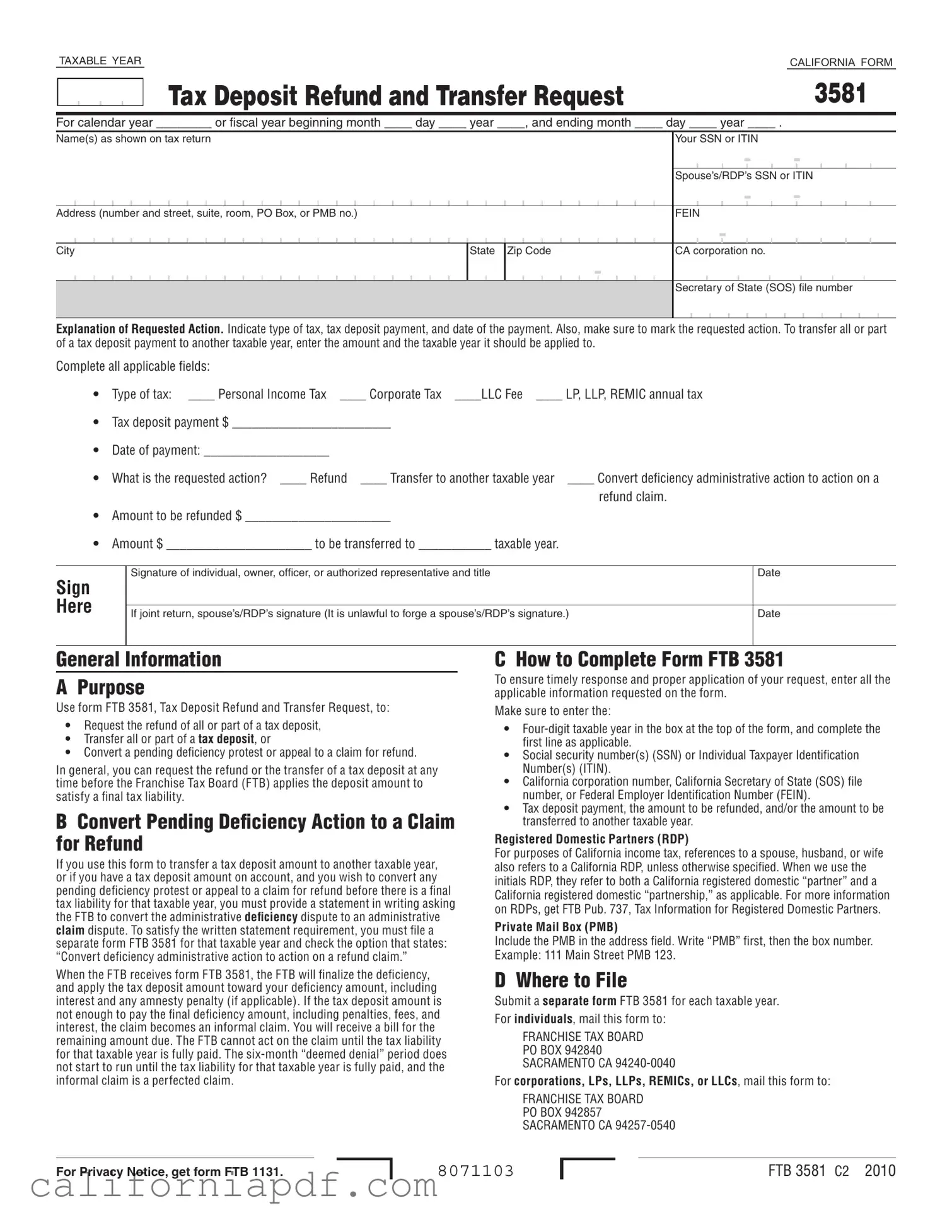The federal Form 1040X, "Amended U.S. Individual Income Tax Return," shares foundational similarities with California's Form 3581 in its purpose to adjust or amend a previously filed tax return. Where the 1040X is applied to amend income and deductions on a federal tax return, Form 3581 provides a mechanism for taxpayers in California to request refund or transfer of their tax deposits for state tax obligations. Both forms necessitate detailed information about the original return, including the tax year in question, and outline the taxpayer's intention to either correct an error or adjust the tax amount based on new information, therefore acting as critical tools in ensuring tax compliance and accuracy of taxpayers’ liabilities.
California Form 3500, "Exemption Application," although serving a different primary purpose, aligns with Form 3581 in its administrative role within the state’s tax framework. While Form 3500 is used by organizations seeking tax-exempt status in California, both it and Form 3581 necessitate comprehensive disclosure of financial information and statuses to the Franchise Tax Board (FTB). These forms also underscore the importance of taxpayers' or organizations’ adherence to regulatory requirements, facilitating a structured approach to fiscal responsibilities and benefits within the state.
The Form 3520, "Power of Attorney," although not directly related to tax refunds or transfers, complements the functionalities of Form 3581 in the broader landscape of tax administration and representation. Form 3520 enables taxpayers to designate representatives to handle their tax matters, which can include filing a Form 3581. The interplay between these documents highlights how representation and direct action by taxpayers coexist within the legal procedures for managing tax engagements, ensuring that individuals and entities can efficiently address their obligations and rights involving tax matters.
"Application for Automatic Extension of Time to File U.S. Individual Income Tax Return," commonly known through its federal designation as Form 4868, parallels California Form 3581 in providing taxpayers with procedural flexibility. While Form 4868 grants an extension for filing a federal tax return, the temporal adjustments allowed by Form 3581 for the application of tax deposits to different taxable years offer taxpayers additional time to organize their finances. Both forms recognize the complexities of financial situations, offering mechanisms to accommodate unforeseen circumstances or strategic financial planning.
Form 540, "California Resident Income Tax Return," serves as the primary vehicle for individuals to report their income, calculate taxes owed, and claim refunds at the state level, directly engaging with components addressed in Form 3581. Where Form 3581 deals with the specific adjustments to tax deposit allocations or refunds, Form 540 encompasses the broader responsibility of reporting annual income and calculating tax liability. The relationship between these forms highlights the comprehensive process of tax compliance, from initial reporting to subsequent adjustments.
Form 588, "Nonresident Withholding Waiver Request," while serving a niche area within California’s tax landscape, shares operational similarities with Form 3581 by facilitating specific taxpayer requests regarding tax handling. Form 588 allows nonresident taxpayers to request a waiver for withholding requirements on income sourced from California, paralleling the request mechanism in Form 3581 that allows taxpayers to direct the application of their tax deposits. Both forms cater to specific taxpayer needs, enabling individualized approaches to tax liability and compliance management.
The Federal Form 8822, "Change of Address," while primarily administrative, indirectly supports the processes associated with California Form 3581 by ensuring that the IRS and, by extension, state tax authorities, are apprised of a taxpayer's current mailing address, which is critical for the proper processing of refunds and transfers. The importance of accurate, current taxpayer information underlies both forms, emphasizing the role of clear communication in the administration of tax matters. This connectivity ensures that administrative and financial actions, such as those facilitated by Form 3581, are executed efficiently and reach the correct parties.

